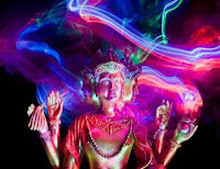 The "first sermon" was the Turning of the Wheel Sutra. In it the newly enlightened Buddha set out the path to five ascetics he had previously practiced with.
The "first sermon" was the Turning of the Wheel Sutra. In it the newly enlightened Buddha set out the path to five ascetics he had previously practiced with. Buddhism is very deep. "Just sitting" is not Buddhism. It's living. Many contemplative traditions have serenity. Buddhism goes beyond.
Buddhism is very deep. "Just sitting" is not Buddhism. It's living. Many contemplative traditions have serenity. Buddhism goes beyond.How? Once there's right concentration, there is another thing one can do: right mindfulness. What is "right" about it? One has already been developing the mindfulness muscle by just sitting and observing. The basis of concentration is mindfulness, and the basis of mindfulness is concentrating. They're interdependent. So let's back up.
Life has three problems. Buddhism has three solutions. The first problem is craving. The solution is absorption (right concentration). The second problem is aversion (fear, anger, hate). The solution is compassion. The third problem is ignorance. The solution is wisdom (enlightenment).
Conditioned states (ourselves and everything around us) are disappointing. Nirvana, the unconditioned, is the solution.
Wait, first things first. What is "Buddhism"? Buddhism is the threefold path of virtue, concentration, and wisdom. That's the compact way of stating it. It is an eightfold path:
"Virtue" means restraint of speech, action, and livelihood. Meditative "concentration" means effort, purification (by samadhi), and mindfulness. "Wisdom" means right view and right thought (or intention).
 The upshot is, when this is, that comes to be. With the ceasing of this, that ceases. What leads to meditative concentration (non-distraction, non-worry, non-remorse)? Virtue. What is virtue? Broadly speaking, it is nongreed, nonhatred, and nondelusion. Practically speaking, it is keeping the five, eight, ten, or 227+ precepts. More simply, it is abstaining from that which tends to disrupt and ruin concentration.
The upshot is, when this is, that comes to be. With the ceasing of this, that ceases. What leads to meditative concentration (non-distraction, non-worry, non-remorse)? Virtue. What is virtue? Broadly speaking, it is nongreed, nonhatred, and nondelusion. Practically speaking, it is keeping the five, eight, ten, or 227+ precepts. More simply, it is abstaining from that which tends to disrupt and ruin concentration.Right concentration is the basis of insight. Insight is liberating wisdom brought about by the systematic practice of insight-exercises (as outlined in a sutra called the Four Foundations of Mindfulness). These practices, when they are potentiated by sufficient concentration, whether that is full absorption or neighborhood/access concentration, lead to enlightenment.



















































































































































































































































No comments:
Post a Comment